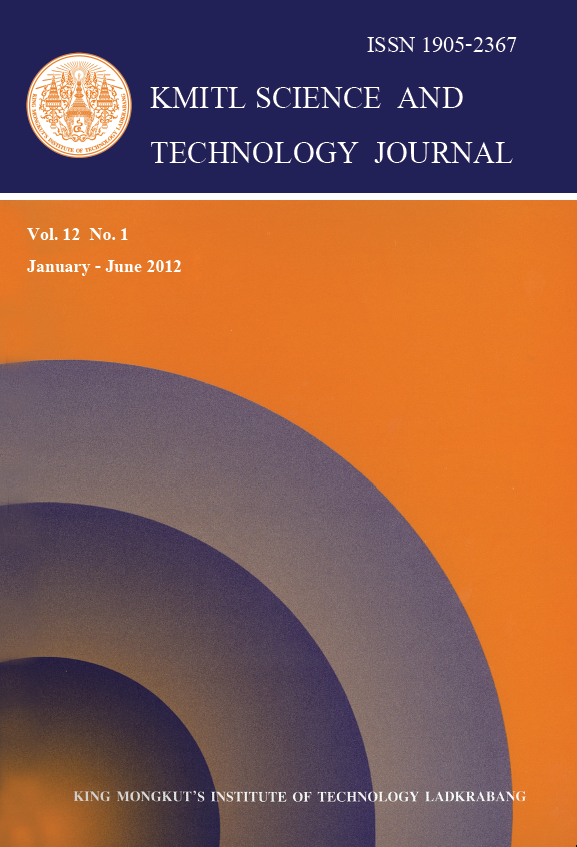Antimicrobial Activities of Crude Extracts from Pomelo Peel of Khao-nahm-peung and Khao-paen Varieties
Main Article Content
Abstract
This study aimed to evaluate crude extracts from pomelo peels of Khao-nahm-peung and Khaopaen varieties for their antimicrobial activities against tested pathogenic and food spoilage microorganisms, Staphylococcus aureus TISTR 118, Bacillus cereus TISTR 5040, Bacillus subtilis TISTR 6633, Listeria monocytogenes DMST 17256, Escherichia coli DMST 4212, Salmonella Typhimurium DMST 0562, Pseudomonas aeruginosa ATCC 27853, Saccharomyces cerevisiae TISTR 5019 and Zygosaccharomyces rouxii TISTR 5044. Susceptibility test by disk diffusion method revealed that crude hexane extract did not inhibit any investigated bacteria, while the crude hexane extract of flavedo of Khao-nahm-peung variety inhibited the tested yeasts.The crude ethyl acetate extract of flavedo inhibited the growth of Gram-positive bacteria and yeasts but this crude extract did not show any inhibition of the tested Gram-negative bacteria. The crude ethanol extract had no antimicrobial activities against any investigated microorganisms at specified concentration in this study.
Keywords: antimicrobial activity, crude extracts, pomelo peel, Khao-nahm-peung, Khao-paen
E-mail: kslincho@kmitl.ac.th
Article Details
Copyright Transfer Statement
The copyright of this article is transferred to Current Applied Science and Technology journal with effect if and when the article is accepted for publication. The copyright transfer covers the exclusive right to reproduce and distribute the article, including reprints, translations, photographic reproductions, electronic form (offline, online) or any other reproductions of similar nature.
The author warrants that this contribution is original and that he/she has full power to make this grant. The author signs for and accepts responsibility for releasing this material on behalf of any and all co-authors.
Here is the link for download: Copyright transfer form.pdf
References
[2] Nychas, G.J., 1994. Natural antimicrobials from plants. In G.W. Gould , ed. 1994. New Methods of Food Preservation. London: Blackie Acadamic and Professional, pp. 58-89.
[3] Walker, J.R.L., 1994. Antimicrobial compounds in food plants. In V.M. Dillon, and R.G.Board, ed. 1994. Natural Antimicrobial Systems and Food Preservation. Wallingford, UK:CAB International, pp. 181-204.
[4] Beuchat, L.R. and Doyle, M.P., 1995. Survival and growth of Listeria monocytogenes in foods treated supplemented with carrot juice. Food Microbiology, 12, 73-80.
[5] Ramful, D., Bahorum, T., Bourdom, E., Tarmus, E. and Aruoma, O.I., 2010. Bioactive phenolics and antioxidant propensity of flavedo extracts of Mauritian citrus fruits: Potential prophylactic ingredients for functional foods application. Toxicology, 278, 75-87.
[6] Mokbel, M.S. and Hashinaga, F., 2006. Evaluation of the antioxidant activities of extracts from buntan (Citrus grandis Osbeck) fruit tissues. Food Chemistry, 14, 529-534.
[7] Abeysinghe, D.C., Li, X., Sun, C.D., Zhang, W.S., Zhou, C.H. and Chen, K-S., 2007. Bioactive compounds and antioxidant capacities in different edible tissues of citrus fruit of four species. Food Chemistry, 104, 1338-1344.
[8] Wang, Y-C, Chuang, Y-C. and Ku, Y-H., 2007. Quantitation of bioactive compounds in citrus fruits cultivated in Taiwan. Food Chemistry, 120, 1163-1171.
[9] Ji, L-L, Luo, Y-M. and Yan G-L., 2008. Studies on the antimicrobial activities of extracts from Eupatorivm lindleyanum DC against food spoilage and food-borne pathogens. Food Control, 19, 995-1001.
[10] Mokbel, M.S. and Hashinaga, F., 2005. Evaluation of the antimicrobial activities of extracts from buntan (Citrus grandis Osbeck) fruit peel. Pakistan Journal of Bioogical Sciences, 8(8),1090-1095.
[11] Mayachiew, P. and Devahastin, S., 2008. Antimicrobial and antioxidant activities of Indian gooseberry and galangal extracts. LWT-Food Science and Technology, 41, 1153-1159.
[12] Clinical and Laboratory Standards Institute (CLSI). 2006. Performance Standards for Antimicrobial Disk Susceptibility Tests; Approved Standard, 9 th Ed. CLSI document M2-A9. CLSI, Wayne, PA.
[13] Nikaido, H. and Vaara, M., 1985. Molecular basis of bacterial outer membrane permeability.Microbiological Reviews, 1, 1-32.
[14] Scherrer, R. and Gerhardt, P., 1971. Molecular sieving by the Bacillum megaterium cell wall and protoplast. Jounal of Bacteriology, 107, 718-735.


